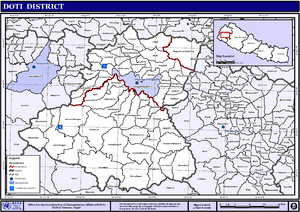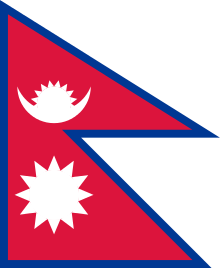Doti District
| Doti डोटी जिल्ला | |
|---|---|
| District | |
 Location of Doti | |
| Country | Nepal |
| Region | Far-Western (Sudur Pashchimanchal) |
| Zone | Seti |
| Headquarters | Dipayal |
| Area | |
| • Total | 2,025 km2 (782 sq mi) |
| Population (2011) | |
| • Total | 211,746 |
| • Density | 100/km2 (270/sq mi) |
| Time zone | NPT (UTC+5:45) |
| Main language(s) | Doteli |
Doti District (Nepali: डोटी जिल्ला![]() Listen ), a part of Seti Zone, is one of the 75 districts of Nepal, a landlocked country in South Asia. This district, with Dipayal as its headquarters, covers an area of 2,025 square kilometres (782 sq mi) with a population of 207,066 in 2001 and increasing marginally to 211,746 in 2011.
Listen ), a part of Seti Zone, is one of the 75 districts of Nepal, a landlocked country in South Asia. This district, with Dipayal as its headquarters, covers an area of 2,025 square kilometres (782 sq mi) with a population of 207,066 in 2001 and increasing marginally to 211,746 in 2011.
History
Doti was a medieval kingdom of Nepal. It was founded by Niranjan Malla Deo, the last son of the Katyuri dynasty and was younger brother of Abhay Pal of Askot. Previously, the area between Ramganga in the west and the Karnali River in the east was under the control of the Rainkas (rulers of the Doti kingdom, alternately "Kumaon" or "Rainka Maharaj").
Ancient Doti covered Uttarakhand of India, and part of far western Nepal. It was formed after the Katyuri Kingdom's disintegration during the 13th century.[1] Doti was one of eight different princely states formed after the disintegration, and all claim Katyuri heritage. The seven other known states are:
- Baijnath-Katyuri
- Dwarahat
- Baramandal
- Askot
- Sira
- Sora
- Sui (Kali Kumaon)
The Katyuri Kingdom's dissolution is attributed to the invasion of Khas Kings Ashoka Challa and Krachalla, from the Karnali zone (Dullu) in 1191 and 1223 respectively.[2] Later, the whole land between Ramganga in the west (Utarakhand) and the Karnali in the east (which divides the far western region from other parts of Nepal), came under the Raikas' rule — after the establishment of the Katyuri's dynastic Raikas Doti. Brahma Dev Mandi at Kanchanpur; a district within Mahakali, was established by Katyuri King Brahma Dev.
Raikas of Doti and their lineage
Historical evidence [3] of the following raikas has been discovered:
- Niranjan Malla Dev (founder of Doti Kingdom beginning of the 13th century)
- Nagi Malla (1238)
- Ripu Malla (1279)
- Nirai Pal (1353) may be from Askot as historical evidence from 1354 AD relating to him has been found in Almora.[4]
- Nag Malla (1384)
- Dhir Malla (1400)
- Ripu Malla (1410)
- Anand Malla (1430)
- Balinarayan Malla (c. 1400 )
- Sansar Malla (1442)
- Kalyan Malla (1443)
- Suratan Malla (1478)
- Kriti Malla (1482)
- Prithivi Malla (1488)
- Medini Jay Malla (1512)
- Ashok Malla (1517)
- Raj Malla (1539)
- Arjun Malla/Shahi (c. 1500 ); ruled Sira as Malla and Doti as Shahi simultaneously)
- Bhupati Malla/Shahi (1558)
- Sagaram Shahi (1567)
- Hari Malla/Shahi (1581; last Raika of Sira, and the adjoining part of Nepal)
- Rudra Shahi (1630)
- Vikram Shahi (1642)
- Mandhata Shahi (1671)
- Raghunath Shahi (1690)
- Hari Shahi (1720)
- Krishna Shahi (1760)
- Deep Shahi (1785)
- Prithivi Pati Shahi (1790; He had fought against the Nepali Ruler (Gorkha Ruler) as also with the British in 1814 AD)[5][6]
Conflict with Gorkha Kingdom
According to Nepal's history, 1790 marked a period of war between Doti and the neighboring Gorkha Kingdom's expansion; Nari-Dang, on the banks of the Seti River. Dumrakot is the location where the Doti forces set up a base to resist the Gorkhas.
Doti was captured by Gorkha forces and annexed to what would later become Nepal, and the Gorkha rulers would destroy several historical sites in Doti — attempting to cover its legendary bravery and tenacity. The Dotyali people were also subject to ethnic prejudice, and were frequently excluded from government jobs and offices of state. Sometime around 1950, a few Dotyalis established their identities as national heroes based solely on their courage, daring, and contribution to their country. Noted among them are Martyr Dashrath Chand Ministry of Home Affairs, Martyr Bhim Dutta Pant Ministry of Home Affairs, and internationally reowned K.I. Singh,[7][8] a revolutionary leader who later became prime minister.
Dotyali language.
Dotiyali is the local language spoken in the Doti region; the far western region of Nepal, which is similar to the Kumauni language. According to Rahul Sankrityayan, Dotiyali is the dialect of the Kumauni language which was brought to Doti by a section of the Katyuri dynasty of Kumaun, which had ruled over Doti until 1790. The Doti kingdom was formed after the Katyuri kingdom had broken up into eight different princely states of different sections of the Katyuris. However, in Nepal it is considered as a Nepali dialect; though Local intellectuals and people speaking Dotiyali language is increasingly demanding that their language to be recognized as one of the national language of Nepal.
Geography and climate
| Climate Zone[9] | Elevation Range | % of Area |
|---|---|---|
| Lower Tropical | below 300 meters (1,000 ft) | 0.1% |
| Upper Tropical | 300 to 1,000 meters 1,000 to 3,300 ft. |
22.2% |
| Subtropical | 1,000 to 2,000 meters 3,300 to 6,600 ft. |
58.8% |
| Temperate | 2,000 to 3,000 meters 6,400 to 9,800 ft. |
17.6% |
| Subalpine | 3,000 to 4,000 meters 9,800 to 13,100 ft. |
1.2% |
Towns and villages

The district contains the following towns and villages:
Banalekh · Banjha Kakani · Barchhain · Basu Devi · Bhawardanda · Bhdhegau · Bhumiraj mandau · Chamara Chautara · Chhapali · Chhatiwan · Dahakalika · Daud · Dhanglagau · Dhirka mandau · Dipayal Silgadhi · [Durga Mandau · Gadasera · Gaguda · Gaihra Gaon · Ganjari · Ghante Shwor · Giri Chauka · Jijodamandau · Kada mandau · Kalena · Kalikasthan · Kana chaur · Kapalleki · Kedar Akhada · Khatiwada · Khir Sain · Lada Gada · Lami khal · Lana Kedareswor · [Lata Mandau · Laxmi Nagar · Mahadevsthan · Mannakapadi · Mudabhara · Mudhe gaon · Nirauli · Pachanali · Pokhari · Rana Gaon · Sana Gaon · Saraswotinagar · Satphari · Seem chaur · Tijali · Tikha · Tikhatar · Toleni · Wagalek · Warpata
See also
- Doti
- Zones of Nepal
References
- ↑ Bhoj Raj Bhattrai. A History of Doti Kingdom.
- ↑ Yaswant Singh Kathoch. A New History of Ittarakhand.
- ↑ Badri Dutt Pandey. History of Kumaun.
- ↑ Advin T. Atkinson (Translated by Ramesh Thapaliyal) (2003). "An old stone has found on the hills of Almora in which name Niraipal and 1348 written". Himalayan Gazetteer Hindi Edition. ISBN 8190100130. p. 267.
- ↑ Advin T. Atkinson(2003). "Doteli King and East Indian Company agreed to help each other". Himalayan Gazetteer Hindi Edition. p. 380.
- ↑ Raja Ram Subedi (1997). History of Karnali Region. Subedi has mentioned Pritivipati Shah went to pilibhit and offered his service to British India.
- ↑ Time magazine. 5 August 1957.
- ↑ The New York Times. 6 October 1982. State Guest of PR of China in 1952 for three years during the rule of Mao Tse-tung & Chou en Lai
- ↑ The Map of Potential Vegetation of Nepal - a forestry/agroecological/biodiversity classification system, . Forest & Landscape Development and Environment Series 2-2005 and CFC-TIS Document Series No.110., 2005, ISBN 87-7803-210-9, retrieved Nov 22, 2013
- Sources
- Districts of Nepal at statoids.com
- A New History of Uttarakhand by Y.S. Kathoach
- Dotiyali language
